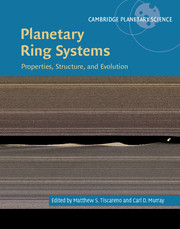Book contents
- Frontmatter
- Contents
- List of Contributors
- Acknowledgements
- I Introductory Material
- II Ring Systems by Location
- 3 The Rings of Saturn
- 4 The Rings of Uranus
- 5 The Rings of Neptune
- 6 The Rings of Jupiter
- 7 Rings Beyond the Giant Planets
- III Ring Systems by Type and Topic
- IV Concluding Material
- Index
- Plate section
- References
7 - Rings Beyond the Giant Planets
from II - Ring Systems by Location
Published online by Cambridge University Press: 26 February 2018
- Frontmatter
- Contents
- List of Contributors
- Acknowledgements
- I Introductory Material
- II Ring Systems by Location
- 3 The Rings of Saturn
- 4 The Rings of Uranus
- 5 The Rings of Neptune
- 6 The Rings of Jupiter
- 7 Rings Beyond the Giant Planets
- III Ring Systems by Type and Topic
- IV Concluding Material
- Index
- Plate section
- References
- Type
- Chapter
- Information
- Planetary Ring SystemsProperties, Structure, and Evolution, pp. 135 - 154Publisher: Cambridge University PressPrint publication year: 2018
References
- 4
- Cited by

